From Hardcore Roots to Kaleidoscopic Pop: Turnstile Reinvents Itself on Never Enough EN/FR
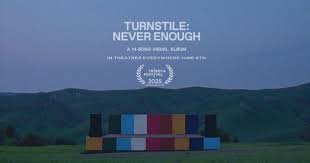
EN
Hardcore bands rarely find themselves in the spotlight, far from Grammy nominations or breaking into the Billboard Top 30. But Turnstile is a clear exception. Their talent has caught the eye of an eclectic mix of artists, from Charli XCX and James Hetfield (Metallica) to Rob Halford (Judas Priest) and even Demi Lovato, who called them her favorite band.
The real game-changer came in 2021 with the release of Glow On. On that album, frontman Brendan Yates completely switched up his vocal style, trading raw screams for melodic singing, while the band pushed into unexpected sonic territory. It’s not every day you hear a band blend the raw speed and intensity of hardcore, think Minor Threat, with the dreamy textures of ‘80s new wave, a genre traditionally at odds with hardcore’s ethos.
Fast forward four years, and the experiments from Glow On feel like they were laying the groundwork for the band’s new record, Never Enough. Yates has ditched the screaming entirely. The lyrics dive into classic emo breakup territory (“lost my only friend,” “it’s unfair”), but his voice and melodies surprisingly channel Sting-era The Police, sometimes even with a touch of AutoTune.
FR
Les groupes de hardcore sont rarement sous les feux des projecteurs, loin des nominations aux Grammys ou du Top 30 américain. Pourtant, Turnstile fait figure d’exception. Leur talent a attiré l’attention de personnalités variées comme Charli XCX, James Hetfield (Metallica), Rob Halford (Judas Priest) et même Demi Lovato, qui les a désignés comme son groupe préféré.
Le véritable tournant s’est opéré en 2021 avec la sortie de Glow On. Sur cet album, le chanteur Brendan Yates a transformé son style vocal, passant de cris rauques à un chant plus mélodique, et le groupe a exploré des horizons musicaux inattendus. Il est rare qu’un groupe parvienne à fusionner l’énergie rapide du hardcore, dans la lignée de Minor Threat, avec la pop new wave des années 80, traditionnellement opposée à l’idéologie hardcore.
Quatre ans plus tard, les expérimentations de Glow On semblent avoir préparé le terrain pour le nouvel album, Never Enough. Yates y a complètement abandonné le chant hurlé. Les paroles abordent des thèmes de rupture amoureuse dans un style emo classique (“lost my only friend”, “it’s unfair”), mais sa voix et ses mélodies rappellent étonnamment Sting de l’époque The Police, avec parfois une touche d’AutoTune.
EN
The album kicks off with a track that echoes Nirvana’s “Rape Me” and “Mystery” from Glow On, a clear nod to their roots. But if that familiar opener makes you think this is just more of the same, think again. While Never Enough shares some visual and sonic DNA with its predecessor, the blue sky and rainbows on the cover feel like a direct answer to Glow On’s pink sky, this isn’t a repeat. It’s a bold, clever sequel that dares to go further, and maybe even outshine the original.
Some ideas from Glow On are brought back and pushed further. The dreamy, Smiths-inspired vibe of Underwater Boi lives on in I Care. And this time around, the guest list gets even more stacked: Dev Hynes (Blood Orange) returns for Seein’ Stars, joined by high-profile collaborators like Hayley Williams (Paramore). Never Enough stretches the band’s sound into wild, sometimes even unsettling places:
- “Dreaming” rides a quirky, vaguely Latin groove with brass flourishes courtesy of jazz-funk crew BadBadNotGood.
- “Sunshower” kicks off at full throttle, slams to a halt, then morphs into a wall of swirling synths and a flute solo by Shabaka Hutchings.
- “Dull” mashes up nu-metal-style anthemic choruses with glitchy electronic verses, likely shaped by hyperpop architect A.G. Cook.
- Elsewhere, you’ll find neon-tinted pop punk (Time Is Happening), Sabbath-style doom riffs (Slowdive), and U2-esque guitar solos paired with dubstep bass drops (Never Enough).
Even with all these sonic detours, the cohesion is stunning. Turnstile keeps you guessing without ever losing the thread, thanks to slick transitions and a natural melodic instinct that shines whether it’s in distorted guitar riffs or shimmering vocal hooks. Tracks like Light Design (synthy pop-rock) and Sole (straight-up hardcore) may be stylistic opposites, but their sheer quality ties them together.
When Glow On dropped, it wasn’t just a breakthrough for Turnstile, it was a seismic shift for the hardcore scene. The album launched them into unexpected territory: Grammy nods, a stadium tour with Blink-182, and prime slots at massive hip-hop festivals. Their rise helped open doors for other hardcore bands to reach bigger stages and broader audiences. The success of Glow On, with its blend of pop sensibility and musical depth, weaving together R&B, dream pop, funk, psychedelia, electronica, grunge, and thrash metal, all while keeping its hardcore backbone, resonated with fans across the board.
Four years later, expectations for Never Enough were sky-high, maybe even unreasonably so. Is it too much like Glow On, or not enough? Too pop, or not pop enough? Has Turnstile strayed too far from their hardcore roots, or are they clinging to them too tightly?
If Never Enough has one flaw, it’s not a lack of creativity or talent, it’s the lingering worry that the band might drift too far from what made them unique in the first place. Tracks like Seein’ Stars, the ballad Magic Man, or the brief Ceiling are all strong songs, but they could almost be from any band playing in the blurred space between modern rock and pop.
FR
Le morceau d’ouverture, qui rappelle “Rape Me” de Nirvana et “Mystery” de leur précédent album Glow On, montre une intention de créer un lien avec leur passé. Cependant, si ce démarrage familier vous laisse penser que l’album sera une simple continuité, préparez-vous à être surpris. Bien que Never Enough partage des similitudes visuelles et sonores avec son prédécesseur (le design de l’album avec son ciel bleu et ses arcs-en-ciel semble répondre au ciel rose de Glow On), il s’agit davantage d’une suite ingénieuse que d’une simple réécriture. Une suite inspirée prenant des risques et qui pourrait peut être surpasser l’original.
Certaines idées de Glow On sont reprises et développées. Par exemple, l’ambiance à la The Smiths d’Underwater Boi se retrouve sur I Care. Les collaborations se multiplient : Dev Hynes (Blood Orange) est de retour sur Seein’ Stars, entouré d’invités prestigieux comme Hayley Williams (Paramore). Never Enough pousse l’exploration musicale encore plus loin avec des incursions surprenantes peut être même dérangeantes:
Dreaming surprend avec une rythmique curieuse, vaguement latino-américaine, et des cuivres apportés par des membres du groupe de jazz-funk BadBadNotGood.
Sunshower démarre à pleine vitesse, s’interrompt brutalement, puis reprend sous la forme d’un mur de synthétiseurs progressifs et d’un solo de flûte signé Shabaka Hutchings.
Dull fusionne des refrains puissants inspirés du nu-metal avec des couplets électroniques glitchy, probablement l’œuvre du producteur AG Cook.
Ailleurs, on trouve du pop punk aux teintes néon avec des échos oniriques (Time Is Happening), des riffs à la Black Sabbath (Slowdive) et des solos de guitare rappelant U2 associés à une basse dubstep (Never Enough).
Malgré la multitude de sonorités disparates, la qualité de Never Enough est impressionnante. Turnstile réussit à surprendre sans jamais choquer, grâce à des transitions fluides et un sens inné de la mélodie, que ce soit sur les riffs distordus ou les lignes vocales pop. Des titres comme Light Design (pop rock synth) et Sole (hardcore traditionnel) se situent aux antipodes stylistiques, mais leur qualité exceptionnelle les unit.
L’album Glow On fut une véritable révolution, non seulement pour Turnstile, mais pour l’ensemble de la scène hardcore. Ce disque a propulsé le groupe vers des sommets inattendus : les Grammys, une tournée des stades avec Blink-182, et des festivals hip-hop grand public. Leur ascension a eu un effet d’entraînement, permettant à d’autres groupes hardcore d’atteindre un public plus vaste et de bénéficier d’une visibilité sans précédent. Le succès de Glow On avec sa sensibilité pop ; sa richesse musicale, qui intégrait le R&B, la dream pop, le funk, le psychédélisme, l’électronique, le grunge et le thrash metal, tout en conservant son essence hardcore, a séduit une grande diversité de fans.
Quatre ans plus tard, les attentes autour de leur nouvel album, Never Enough, étaient colossales et quasi impossibles à satisfaire. Est-il trop similaire ou trop différent ? Trop pop ou pas assez ? Est-il trop éloigné de leurs racines hardcore ou tente-t-il de s’y accrocher ?
Si le nouvel album a un défaut, ce n’est pas le manque d’idées ou de talent, mais plutôt la crainte que Turnstile ne s’éloigne trop de ses racines, expérimente trop loin risquant de diluer son identité sonore. Des morceaux comme Seein’ Stars, la ballade Magic Man ou le bref Ceiling sont excellents en soi, mais pourraient être l’œuvre de n’importe quel groupe naviguant dans la zone grise entre le rock et la pop actuelle.
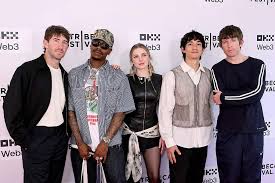
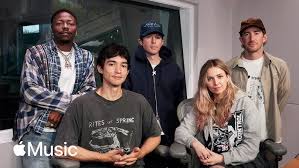
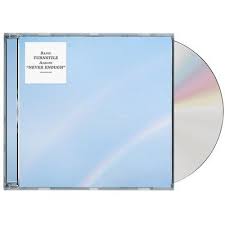
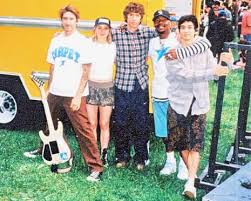

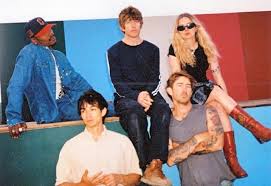
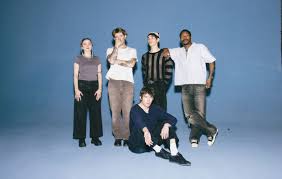
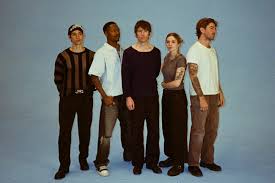
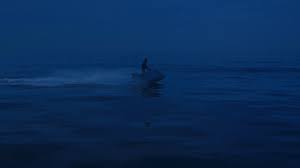
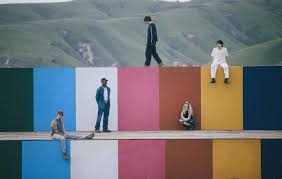
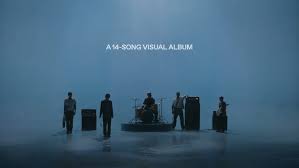
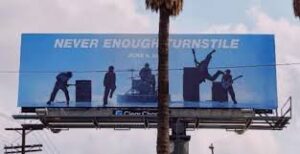
EN
To bring their vision to life, Brendan Yates and guitarist Pat McCrory directed a music video for every track on the album, turning Never Enough into a full-on visual experience. Some scenes already feel inseparable from the songs themselves, a testament to how Turnstile is leaning more than ever into the power of the studio (they recorded at The Mansion, Rick Rubin’s legendary studio) and ambitious music video production. The “Midsommar”-inspired mosh pit scene in the video for “Birds” captures the band’s live-wire energy right in your living room, echoing the album’s creative spirit.
At the heart of all these sonic experiments is Turnstile’s unmistakable identity. Whether it’s the dreamy synths of “Magic Man” or the funky guitars in “Seein’ Stars,” their sound is instantly recognizable. While large chunks of Never Enough veer far from traditional hardcore, the usual question floating around social media, “Is Turnstile still a hardcore band?”, misses the point. The real question is: Is Turnstile still true to themselves? And the answer is a resounding yes. These genre-blurring moments don’t feel forced or indulgent, they’re woven seamlessly into the kaleidoscopic fabric of Never Enough.
That hardcore foundation taught Turnstile the value of restraint. Even as their sound expands, they know how to keep things tight and impactful. Their unlikely rise into the mainstream shows no signs of slowing down, and Never Enough proves they’re just getting started.
FR
Pour renforcer leur vision, Brendan Yates et le guitariste Pat McCrory ont créé des clips pour chaque chanson, formant un véritable film qui accompagne l’album. Certains moments sont déjà indissociables des morceaux, prouvant que Turnstile exploite de plus en plus la puissance du studio (ils ont enregistré à The Mansion, le célèbre studio de Rick Rubin) et des clips musicaux ambitieux. La scène de mosh “Midsommar” du clip de “Birds” offre un aperçu de l’énergie live du groupe, directement chez vous, avec la même intention artistique que l’album.
Le fil conducteur de toutes ces fusions reste l’identité singulière de Turnstile. Que ce soient les synthés oniriques de “Magic Man” ou les guitares funky de “Seein’ Stars”, le son est instantanément reconnaissable. Bien que de nombreux passages de Never Enough ne relèvent pas du hardcore traditionnel, la question récurrente sur les réseaux sociaux, “Turnstile est-il toujours un groupe hardcore ?”, est réductrice. La vraie question est : “Turnstile reste-t-il fidèle à lui-même ?” Et la réponse est un oui retentissant. Ces moments se fondent harmonieusement dans l’ensemble kaléidoscopique de Never Enough. La profusion d’idées est traitée avec une telle habileté qu’elle ne semble jamais excessive ou complaisante. L’ancrage hardcore de Turnstile leur a appris l’importance de la concision. Leur ascension inattendue vers le grand public est, sans aucun doute, loin d’être terminée.
Written by DeeDee
Explore our latest music reviews!
Découvrez nos dernières chroniques musicales !


